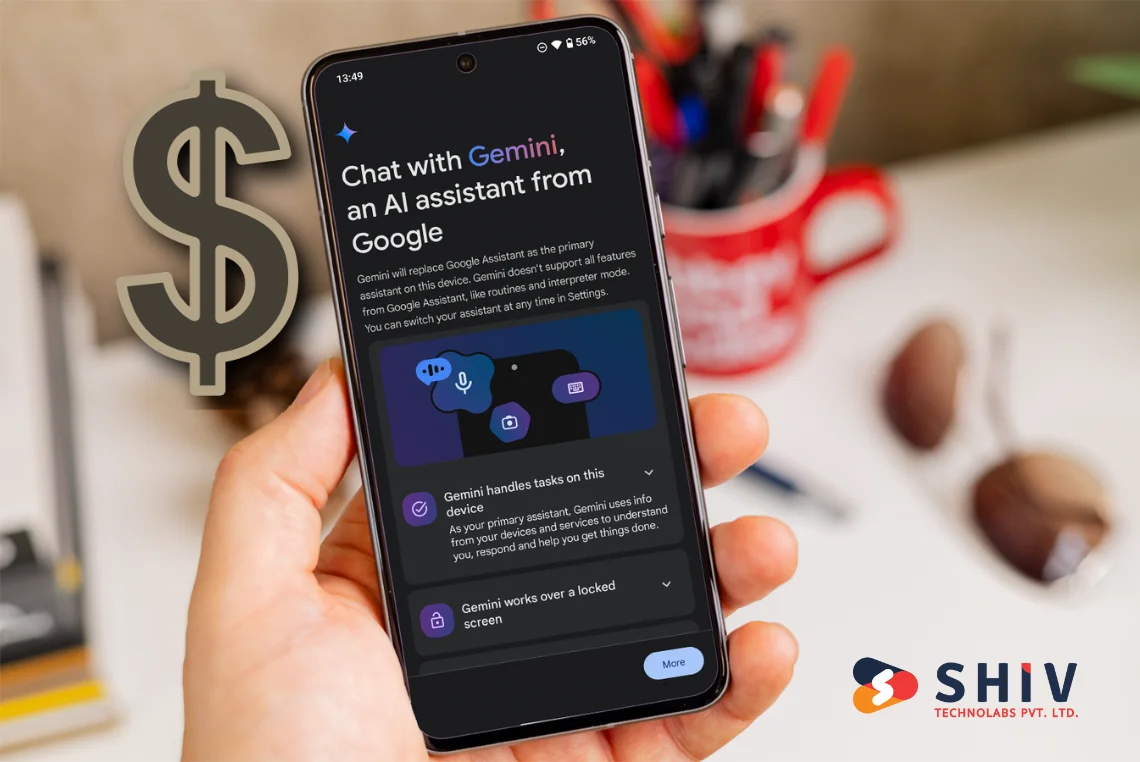Table of Contents
Artificial intelligence now shapes how people use apps. A key use case is the AI-powered avatar. Shiv Technolabs, an AI Development Company, builds avatars that listen, speak, and react in real time. These characters add life to key flows. They raise engagement and fit each person’s style. You see them in support, social, retail, learning, and games.
This guide shares practical steps, core tech, and design tips. You will learn to build avatars that look good and respond fast. Each section ties choices to real user needs.
An AI-powered avatar is a software character inside an app. It chats by text or voice and guides key flows. It can act as a helper, companion, or brand face. Simple builds use fixed replies. Advanced builds keep context, learn patterns, and handle multi-step tasks.
The draw is a human-like connection. With clear feedback and personal context, replies can feel natural. As the avatar learns habits and adapts to each person, engagement and satisfaction often rise.
Why are AI Avatars Gaining Popularity?
![]()
- Enhanced User Engagement: AI avatars can keep users more engaged by providing real-time responses, personalized suggestions, and a relatable presence within the app.
- Personalized Experience: AI avatars learn from user interactions, creating a tailored experience that keeps users coming back.
- Streamlined Support: Many businesses integrate avatars into customer service applications, reducing wait times and improving user satisfaction by automating responses to common questions.
In the sections below, we’ll go over how to create an effective AI-powered avatar that meets both business objectives and user expectations.
Defining User Needs and Audience
Designing an AI avatar begins with understanding the user base and identifying specific needs and expectations. This preliminary research sets the foundation for the avatar’s look, feel, and functionality.
# Key Questions to Consider:
What is the Avatar’s Primary Role?
Define the purpose: Is the avatar a customer service agent, a personal trainer, a virtual friend, or a shopping assistant? The avatar’s role will shape every aspect of its design and behavior.
Who is the Target Audience?
Understanding the demographics, cultural preferences, and even specific industries can help tailor the avatar’s appearance and interactions. For example, a virtual health assistant might be tailored to convey empathy and calmness, while a gaming avatar might emphasize energy and enthusiasm.
Frequency and Duration of Interactions
Will users engage briefly or for extended periods? Regular, brief interactions might require a simpler design, while extended interactions benefit from more complex features and capabilities to maintain interest.
User Profile Creation
To align the avatar with user expectations, create detailed profiles of your target audience. Each profile should outline potential user needs, preferences, and interaction patterns. For instance, an educational app for young students might benefit from avatars that are colorful, expressive, and relatable, while a business tool might need a more professional and subdued avatar.
By defining user needs clearly, you set a strong foundation for designing an avatar that aligns with user expectations and enhances their app experience.
Core Components of AI Avatars
The success of an AI-powered avatar lies in a combination of design, interactivity, and intelligence. Let’s dive into the main components:
a. Visual Design
The visual design of an avatar is critical. It should not only be appealing but also suitable for the context of the app. Important design decisions include:
- Style Choices: Avatars can range from hyper-realistic to cartoonish. The style should match the app’s purpose and appeal to the target audience.
- Customization Options: Allowing users to personalize avatars (adjust hair color, clothing, or expressions) adds a layer of engagement, making users feel more connected to the character.
b. Speech and Text Communication
Avatars can communicate through voice, text, or both, depending on the app’s needs. Key considerations include:
- Text-based Interactions: Text communication is useful for situations where users need specific information, such as in customer support.
- Voice Recognition and Synthesis: In scenarios where a hands-free experience is ideal (like fitness apps), speech recognition allows users to interact by speaking naturally, while voice synthesis creates a more realistic response.
c. Gestures and Facial Expressions
Non-verbal communication brings avatars to life. Expressions, gestures, and subtle movements make the interaction feel authentic.
- Adaptive Gestures: Movements such as nodding, smiling, or raising eyebrows make the avatar seem more responsive and attentive.
- Emotion Recognition: Some avatars incorporate emotion recognition, allowing them to detect user emotions and adjust their responses accordingly.
d. Contextual Awareness and Memory
Contextual awareness allows avatars to provide responses that are relevant to the user’s history, preferences, and real-time data.
- Context-based Responses: For example, a customer service avatar could reference previous interactions to provide faster, more accurate answers.
- Environmental Adaptation: Avatars that respond to data like time, weather, or location can create more connected experiences.
These components form the basis of any AI-powered avatar, bringing together visual appeal and interactivity to deliver an engaging experience.
Best Practices for Avatar Design
Designing an AI-powered avatar involves a balance of functionality, aesthetics, and usability. Here are some best practices:
a. Allow User Control
Users should have the option to control their interaction with the avatar. This could mean enabling or disabling features, adjusting avatar responses, or customizing the avatar’s appearance. Allowing users this flexibility prevents the avatar from becoming intrusive.
b. Align with Brand Identity
An avatar should reinforce the brand’s identity, aligning with its tone and purpose. An avatar representing a financial app might appear professional and calm, while one in a lifestyle app could be vibrant and energetic.
c. Design for Inclusivity
Avatars should be designed to represent diverse audiences, offering variations in appearance that reflect different demographics. Additionally, consider accessibility features to support users with disabilities, such as text descriptions for visual cues or closed captions for spoken interactions.
d. Balance Animation and Subtlety
While animations make avatars engaging, too much movement can be distracting. Subtle animations, like slight nods or expressions, add personality without overwhelming the user.
e. Maintain Consistency in Tone
Consistency in responses and behavior builds trust. The avatar should have a defined tone that aligns with the app’s voice, whether friendly, formal, or supportive. This ensures a cohesive experience across user interactions.
Integrating AI for a Responsive Experience
AI-powered avatars rely on advanced algorithms to offer intelligent and responsive interactions. Core AI technologies to consider include:
a. Natural Language Processing (NLP)
NLP allows avatars to understand user input in natural language, including idioms, slang, and varied sentence structures. It also enables the avatar to respond more naturally, making the interaction feel less robotic and more conversational.
- Sentiment Analysis: By detecting user sentiment (e.g., frustration or joy), the avatar can adapt its responses to be more empathetic or enthusiastic as needed.
b. Machine Learning for Adaptive Learning
Machine learning enables avatars to learn from user interactions over time. For example, if users frequently ask for specific information, the avatar can start offering it proactively.
c. Emotion Recognition
Emotion recognition adds an extra layer of personalization. For example, a health app avatar can detect signs of stress and adjust its tone to be more calming, offering empathetic support in times of need.
Security, Privacy, and Ethical Considerations

Building an AI-powered avatar involves handling personal data, which requires careful attention to security and ethics.
a. Data Privacy
Protecting user data is paramount. Sensitive information such as facial recognition data, voice samples, and user preferences must be stored and processed securely to comply with regulations like GDPR and CCPA.
b. Avoiding Bias and Ensuring Fairness
AI models can unintentionally reflect biases present in the training data. Testing models across diverse data sets can help prevent biases and ensure fair interactions with all users.
c. Transparency and User Consent
Users should be informed about what data is being collected, why, and how it will be used. Clear communication fosters trust, giving users the option to manage their data as they see fit.
Future Trends and Opportunities in AI Avatars
As AI technology progresses, avatars are set to become even more dynamic and capable. Here are some trends on the horizon:
- Improved Emotional Intelligence: Future avatars will detect nuanced emotions, making interactions feel more genuine and responsive.
- Lifelike Visuals and Movements: Advances in computer graphics will enable avatars to appear and move more realistically, enhancing the sense of connection.
- Cross-Platform Consistency: Avatars may soon synchronize across platforms, enabling users to maintain the same avatar across different applications, creating a unified experience.
Conclusion
AI-powered avatars represent a powerful way to create engaging, interactive, and personalized digital experiences. By understanding user needs, focusing on thoughtful design, and addressing privacy concerns, developers can create avatars that feel personal, relatable, and beneficial. As AI technology continues to evolve, the future holds exciting possibilities for more advanced and interactive avatars that enrich user engagement across a variety of industries.
This guide provides a foundation for building avatars that blend the best of design and technology, setting the stage for digital interactions that feel as real as they are innovative.
Looking to bring AI-powered avatars into your app? Shiv Technolabs, a leading mobile app development agency with expertise in creating intelligent, interactive solutions, can help. Our mobile app development services in Singapore deliver customized, user-centered applications that engage and captivate. Let’s build an app experience that not only meets but exceeds user expectations—connect with Shiv Technolabs today!
FAQs
What are AI-powered avatars?
AI-powered avatars are in-app characters that talk, listen, and act in real time to guide users.
How do AI avatars work?
They use NLP for intent, a dialog manager for context, speech recognition and TTS for voice, animation for cues, and memory for preferences.
Why use AI avatars in apps?
They deliver faster help, reduce friction, and increase retention with personal, context-aware replies.



















